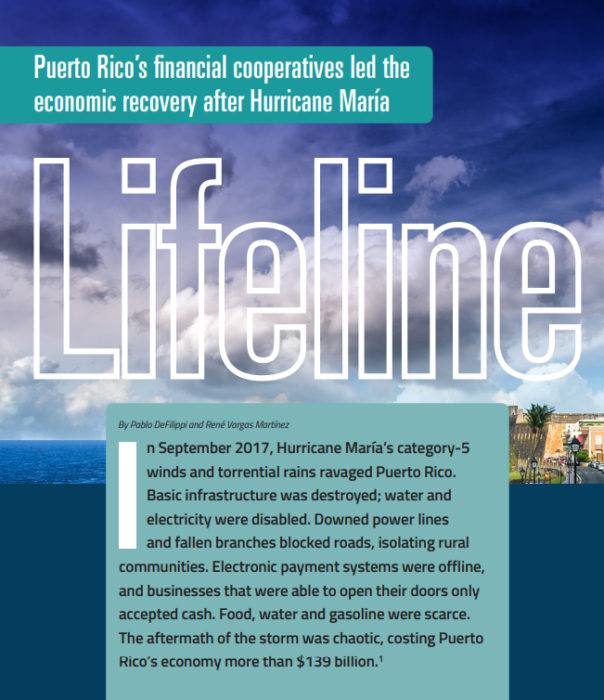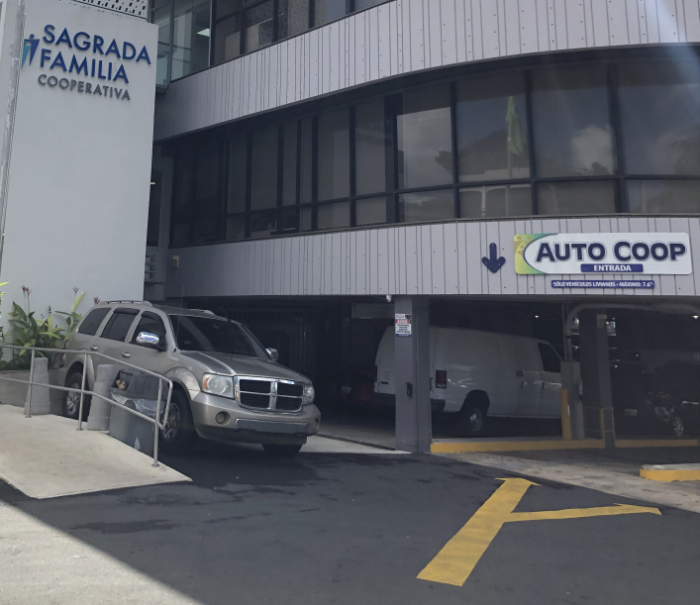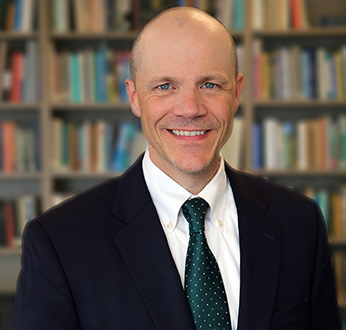
Summer 2019 – Staying Power
Lifeline
Puerto Rico’s financial cooperatives led the economic recovery after Hurricane María
By Pablo DeFilippi and René Vargas Martínez
In September 2017, Hurricane María’s category-5 winds and torrential rains ravaged Puerto Rico. Basic infrastructure was destroyed; water and electricity were disabled. Downed power lines and fallen branches blocked roads, isolating rural communities. Electronic payment systems were offline, and businesses that were able to open their doors only accepted cash. Food, water and gasoline were scarce. The aftermath of the storm was chaotic, costing Puerto Rico’s economy more than $139 billion.1
In the days that followed, Puerto Rico’s financial cooperatives immediately responded, becoming critical to the survival of the island’s underserved communities in a time of crisis. Now — stronger than ever — these cooperatives are poised to transform the island’s economy.
An integrated cooperative ecosystem
Puerto Rico has an extensive network of community-owned financial cooperatives deeply rooted in its rural communities, where most traditional financial institutions do not have a presence. These institutions promote financial inclusion through affordable banking services and access to credit. Today, there are 113 state-chartered financial cooperatives and nine federal credit unions on the island. As a whole, Puerto Rico’s financial cooperative system has $8.8 billion in community-owned assets and over 1 million member-owners.2
Puerto Rico’s cooperative movement has existed for more than a century, but the cooperative way of life can be traced back to the Taíno Indians, who organized collectively to fulfill their basic needs. It wasn’t until the 19th century that the cooperative principles took hold in Puerto Rico. The first cooperative on the island was established in 1873, when it was still a Spanish territory. The “Los Amigos del Bien Público” used collective savings to help members during difficult times, such as health crises or deaths in the family. The cooperative also offered financial education and other services to its members.
After the Spanish-American War, Puerto Rico experienced a lull in cooperative development due to changes in colonial administration. But in 1906, Puerto Rican lawyer and politician Rosendo Matienzo Cintrón established the framework for a cooperative movement and, in 1920, the House of Delegates approved the first law that established the structure and operation of consumer cooperatives in Puerto Rico. In the 1940s, consumer cooperatives expanded in rural towns and cities across the island. In 1946, the General Law of Cooperatives of Puerto Rico was approved and, in 1948, the Puerto Rico League of Cooperatives was established.3
Puerto Rico’s financial cooperative system has $8.8 billion in communityowned assets and over 1 million member-owners.
The cooperative business model enjoyed support from prominent institutional and political figures in Puerto Rico who actively promoted the movement and even helped establish cooperatives across the island. These men and women were the most important political figures of the era, and are still remembered today. The Catholic Church, too, played a pivotal role in promoting the cooperative philosophy early on, helping create more than 35 cooperatives across the island.
After these breakthroughs, the expansion of the cooperative movement in Puerto Rico was unstoppable. Additional laws were approved to regulate all sectors and types of cooperatives. A cooperative bank, Bancoop, was created to support cooperative activities. Cooperative loan funds such as Fidecoop4 were also established, along with other institutions that are now central to the cooperative movement.
This strong cooperative tradition, rooted in more than a century of growth and development, has created an integrated cooperative ecosystem. Financial, worker, service and housing cooperatives work together to help finance and promote one other. They also invest in new cooperatives structures and maintain joint ventures that serve the movement as a whole. There is a cooperative loan fund for new co-op development, two cooperative insurance companies, co-op supermarkets and pharmacies. This vast cooperative ecosystem sustains itself and works for the benefit of the communities in which it operates.
What makes Puerto Rican financial cooperatives unique
Financial cooperatives in Puerto Rico are very similar to credit unions in the U.S. They were organized with the same mission: To serve people who have been excluded from the financial mainstream and offer quality community-owned financial services. Members of financial cooperatives are called socios and, just like credit unions on the mainland, they are member-owners. Yet there is a distinct difference between the two models.

In a credit union, members deposit their money in regular shares. By doing so, they are owners of one share of the credit union, and can run or vote for their respective board. Members of financial cooperatives also deposit money in regular shares, but in order to maintain their membership, they must also make monthly deposits to a restricted share account. These shares are separate from regular shares deposits, and are called acciones. This contribution is considered restricted capital, and if the financial cooperative is profitable, the members get a percentage of their shares. Members can also apply for low interest loans based on their restricted share balance, and part of the interest they pay goes to this account. They can withdraw their shares if they decide to end their membership in the cooperative, or if they have a financial emergency.
This difference is key because it means members of financial cooperatives have a vested financial interest in their institutions. They actively participate in the development of the financial cooperative by attending annual meetings and engaging in lively debates about the cooperative’s financial well-being and its new initiatives. They consider the financial cooperative to be their property. This sense of ownership means the employees and executives who work at the financial cooperative are hyper-focused on the members and communities they serve.
Financial cooperatives during and after Hurricane María
Financial cooperatives’ response to Hurricane María was multi-pronged. Telecommunications systems were down, representing a challenge to financial cooperatives whose members depended on direct deposit and ACH transfers to access desperately-needed funds. To ensure that these electronic deposits were processed, local financial cooperatives each sent a representative—in many cases, their CEO—to the National Cooperative Bank in San Juan, where ACH transfers are cleared, with a thumb drive to exchange the ACH files. This strategy was critical during the first three weeks after the storm, when most communications systems were down.









